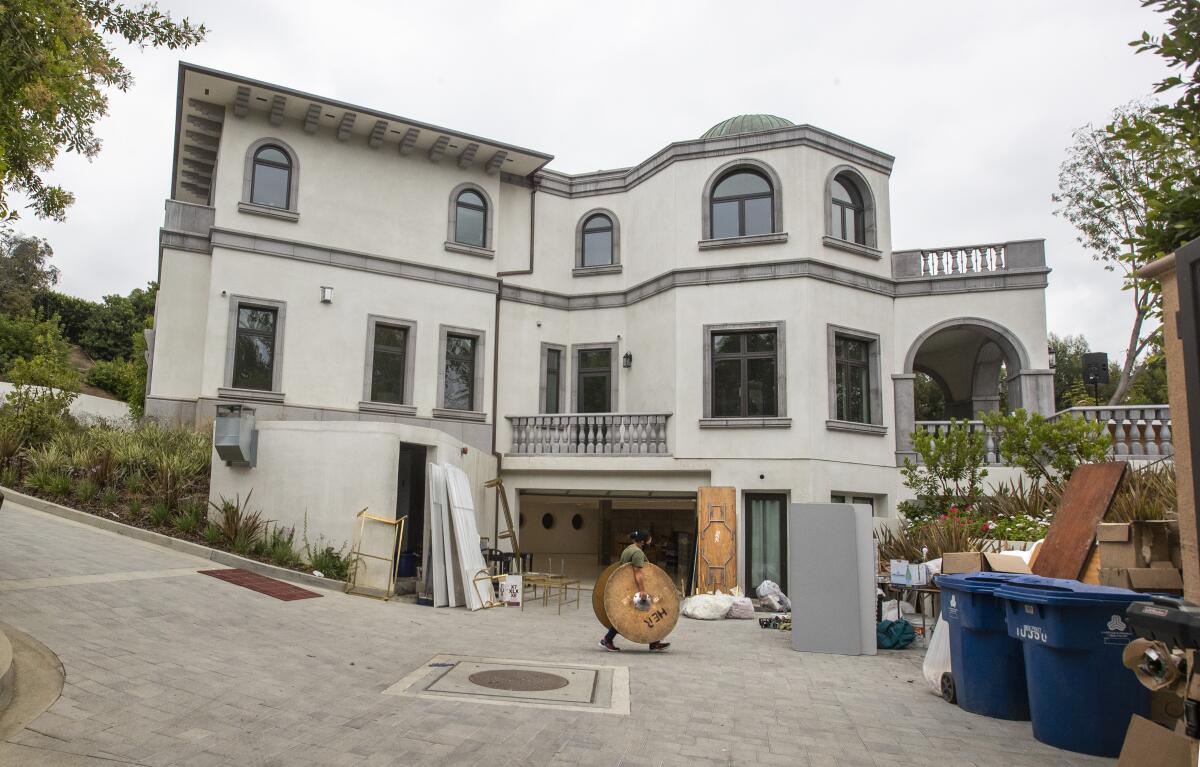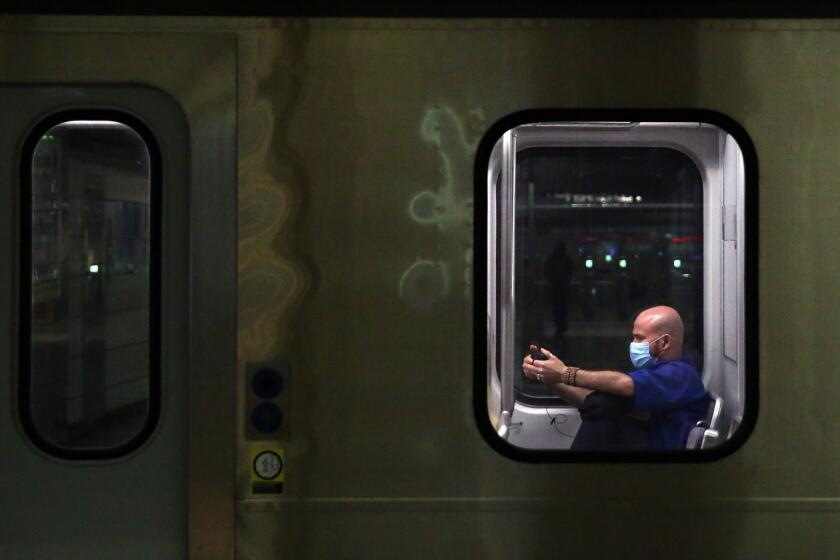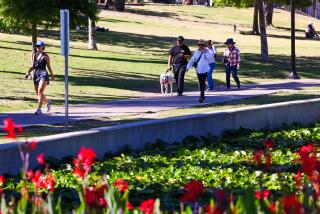Raucous parties, young adults fueling California’s COVID-19 crisis

- Share via
Younger adults are fueling California’s COVID-19 pandemic like never before, health officials are warning, and raucous parties and other large social gatherings are threatening to unravel the progress the state is making.
A second surge of COVID-19 cases in Los Angeles County has been fueled by skyrocketing growth in disease transmission and hospitalizations among the youngest adults. Residents under the age of 50 now make up 60% of new coronavirus cases in L.A. County, the county’s public health director, Barbara Ferrer, said.
And officials warn that the spread among younger adults is transmitting the virus to those who are vulnerable. California’s cumulative COVID-19 death toll surpassed 10,000 on Thursday, a Los Angeles Times tally found, with the number of total cases surpassing 540,000.
Young people may feel they are at low risk of becoming seriously ill or dying of the virus. But experts say they can serve as “super spreaders,” easily transmitting the illness to others who are more vulnerable, especially older relatives.
The surge in California over the last two months had several causes, including the reopening of the economy that allowed the coronavirus to spread rapidly among low-wage workers, many of them Latino essential workers whose employers haven’t followed new infection control rules. But summer celebrations among young people are also a recurring problem, and one particularly frustrating to officials trying to slow outbreaks.
“As long as you have any member of society — any demographic group — who is not seriously trying to get to the endgame of suppressing this, it will continue to smolder and smolder and smolder,” Dr. Anthony Fauci, the U.S. government’s top infectious diseases expert, said this week.
It’s important to ask, Ferrer said, “why so many people are willing to put our entire community at risk during this unprecedented pandemic.”
L.A. County has had a number of outbreaks among younger adults. At least 45 people linked to three fraternities associated with USC have become infected, as has a group of USC graduate students who have socialized, studied or lived together, Ferrer said.
“And at UCLA, we’ve seen a number of football players who returned to campus and tested positive,” Ferrer said.
UC Berkeley in July reported that most of the 47 new cases reported in a single week stemmed from parties connected to fraternities. The outbreak was a factor in the university’s decision to go with fully remote instruction for the fall semester.
Mayor Eric Garcetti announced Wednesday that he will be authorizing the city to shut off water and power in cases where residents host large, illegal gatherings.
Health officials have been dismayed at ongoing reports of large parties in the midst of the worst global pandemic in more than a century. An investigation has been launched into a party allegedly thrown for first responders at a Hollywood bar last week, despite a statewide order shutting bars down.
On Monday night, hundreds of people gathered at a mansion on Los Angeles’ Mulholland Drive at a party so big it attracted the attention of television news helicopters. The party, which drew numerous noise complaints before sundown, continued past midnight, when shots rang out, leaving one woman dead and four other people injured.
Concern is also growing that young adults are heading to parties at private homes in tony areas of the city, especially the Hollywood Hills. Los Angeles Mayor Eric Garcetti on Wednesday night authorized shutting off water and electricity service to homes that had repeatedly hosted large parties in defiance of the ban on gatherings.
“While we have already closed all nightclubs and bars, these large house parties have essentially become nightclubs in the hills,” Garcetti said. “These large parties are unsafe and can cost Angelenos their lives.”
Hours after Garcetti’s announcement, police were summoned to the Holmby Hills area after receiving multiple noise complaints about a massive gathering at a mansion. Video showed dozens of people outside, dancing and posing for pictures. Most were not wearing masks.
The crowd, reportedly guests at a large wedding reception, dispersed after police arrived shortly before midnight.
Statewide, adults ages 18 to 34 make up more than one-third of all infections. In Silicon Valley, coronavirus case rates are increasing particularly fast among people in that age group, said Dr. Sara Cody, Santa Clara County’s health officer.
At Zuckerberg San Francisco General Hospital in early July, the average age of hospitalized COVID-19 patients was 41, said Dr. Grant Colfax.
“The people in the hospital ... are not only the elderly and most frail,” Colfax, San Francisco’s public health director, said recently. “Young people, middle-aged people, older people — we are all at risk for this disease.”
In L.A. County, new coronavirus cases among adults in their 30s and 40s nearly tripled from the beginning of June to July 24. Adults in their 30s and 40s contracted the virus at a daily rate as high as 1,122 cases per 100,000 over the previous seven days.
No other age group has a higher case rate.
The youngest adults saw even faster growth. The rate among those 18 to 29 quadrupled from early June to the end of July, from 200 cases per 100,000 residents to 882 cases per 100,000 residents, Ferrer said.
“This explosive growth in cases,” she said, “shows that these two age groups continue to drive new infections here in the county, and they’re making up the bulk of our new cases.”
Adults under 50 are particularly likely to socialize with people outside their household — perhaps spurred by the knowledge that their age group is less likely to die from COVID-19.
“This is also the age group that’s most likely to be attending the large parties that we keep seeing,” Ferrer said. “Gatherings of people from different households are such a bad idea at this point in time.”
Gatherings are banned in L.A. County “because they create a lot of risk for transmission at activities that really are not essential,” she said. Parties and gatherings “hurt all of us” and, further, make it less likely that children can get back to school anytime soon, allowing more parents to return to work.
“We ask that everyone make good decisions: Don’t host large parties. And don’t attend a party if you’re invited,” Ferrer said. “It isn’t worth the risk you run, and it certainly isn’t worth the risk you’re creating for our collective recovery journey.”
Gov. Gavin Newsom said Wednesday that 12,807 new coronavirus infections had been reported statewide in the past 24 hours — a record high.
Young adults infected with COVID-19 are also increasingly being hospitalized.
Adults ages 18 to 29 now account for 10% of COVID-19 hospitalizations in L.A. County, double the number in May. Adults in their 30s and 40s account for 1 of every 4 COVID-19 hospitalizations.
Social young adults have also become vectors for the disease in other nations. A study in Japan found that among 61 clusters of illness, it was most often adults in their 20s or 30s — infected but not showing signs of illness — who were responsible for spreading the infection.
And although it’s still true that the oldest adults are most likely to die from COVID-19, hundreds of younger adults have died from the disease in L.A. County. Among residents in their 30s and 40s, 319 have died, and 32 adults under 30 also have died.
“No matter how young you are,” Ferrer said, “you are at risk for death from COVID-19.”
L.A. County Supervisor Hilda Solis said officials will advertise on billboards and post on Twitter, Facebook and Instagram an educational campaign that warns younger adults that the pandemic is a threat to them. “The risk is real,” she said.
Young people can have a false impression that partying only hurts themselves if they get infected, Fauci said at a forum hosted Wednesday by the Harvard T.H. Chan School of Public Health.
What they don’t realize is that once infected, they likely will become a silent spreader of disease. About 40% of people who get infected show no symptoms but can easily infect others.
“If you get infected — even if you have no symptoms — you are part of the propagation of the pandemic,” Fauci said Thursday at an event hosted by the Alliance for Health Policy. “Because your getting infected ... means it’s like you’re going to innocently and inadvertently infect someone else.
“You can be part of the problem of propagating the outbreak, or you can be part of the solution,” Fauci said. “Don’t be the weak link in the chain.”
Times staff writers Leila Miller, Richard Winton and Luke Money contributed to this report.
More to Read
Sign up for Essential California
The most important California stories and recommendations in your inbox every morning.
You may occasionally receive promotional content from the Los Angeles Times.












